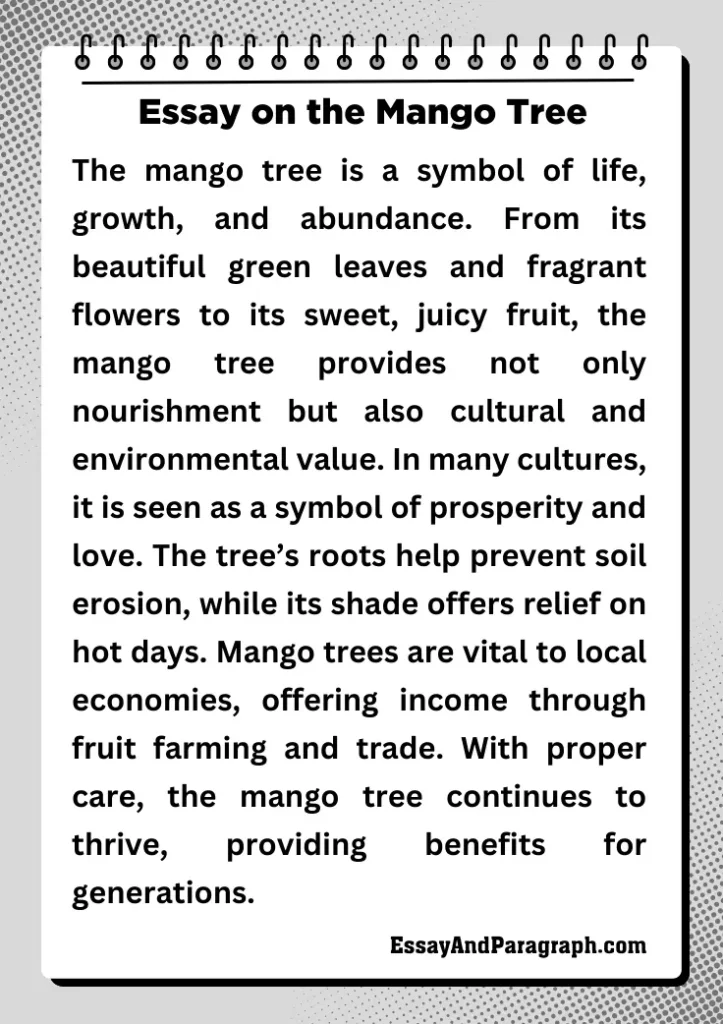Ever wondered how one tree can bring so much joy, shade, and even delicious fruit? The mango tree is one of the most loved and cherished trees around the world. Known for its rich history, cultural significance, and, of course, its mouthwatering fruit, the mango tree holds a special place in many people’s hearts. In this article, we will explore how to write an essay on the mango tree and dive into its unique features, benefits, and the way it connects with people worldwide.
10 Lines Essay on the Mango Tree
The mango tree is a large and beautiful tree.
It is known for its sweet and juicy fruit called mango.
Mango trees are found in many countries, especially in tropical climates.
The tree has a tall, thick trunk and large, green leaves.
Mangoes grow on the branches of the tree in clusters.
The mango tree blooms with small, fragrant flowers before producing fruit.
Mangoes are harvested when they are ripe and turn a yellow or red color.
People enjoy eating mangoes in different ways, like in smoothies, desserts, and salads.
The mango tree provides shade and is often seen in parks and gardens.
The mango tree is also known for its symbolic importance in many cultures.

10 Lines Essay on the Mango Tree
Short Essay on the Mango Tree
The mango tree is one of the most beloved trees worldwide. It is famous for its sweet and juicy fruit, the mango, which is enjoyed by people of all ages. Mango trees are native to South Asia but are now found in tropical regions around the globe. They are large, with a thick trunk and dense canopy, providing ample shade for people to relax under.
The tree’s leaves are shiny and green, and the flowers bloom in clusters, giving off a pleasant fragrance. The fruit of the mango tree is typically harvested when it is ripe, with its color ranging from green to yellow to red, depending on the variety. The taste of the mango is sweet and tangy, making it a popular ingredient in a wide range of dishes and beverages.
Mango trees also have a rich cultural significance. In many parts of the world, they are seen as symbols of love, prosperity, and fertility. The mango tree’s long lifespan and ability to provide fruit year after year make it a symbol of enduring strength and vitality. People plant mango trees in their homes, gardens, and parks, not only for the fruit but also for the beauty they add to the landscape.
In addition to their cultural importance, mango trees contribute to the environment. They help in preventing soil erosion with their deep root systems and provide habitat for various animals, such as birds and insects. The mango tree, with its many benefits, is truly a remarkable and cherished plant in our world.
Long Essay on the Mango Tree
The mango tree is much more than just a source of delicious fruit. It is a symbol of prosperity, culture, and nature’s bounty. Native to South Asia, the mango tree has spread across the globe, thriving in tropical and subtropical climates. It is a majestic tree, often growing to a height of over 100 feet, with a thick trunk and a wide, rounded canopy. Its green, glossy leaves and fragrant flowers are the first signs that the mango tree is blooming, creating a vibrant display of nature’s beauty.
The mango tree is most famous for its fruit, which is one of the most popular tropical fruits in the world. The mangoes grow in clusters on the branches, gradually ripening as they absorb sunlight. Mangoes are typically harvested when they turn a golden yellow or a rich red color, depending on the variety. When you bite into a ripe mango, you experience a sweet, tangy flavor that is beloved by many. The versatility of the mango means it can be eaten raw, added to smoothies, or used in savory dishes like salads and salsas.
Beyond its delicious fruit, the mango tree holds great cultural significance in many parts of the world. In India, for instance, the mango is considered the “king of fruits” and is associated with the Hindu goddess Lakshmi, who symbolizes wealth and prosperity. In some cultures, the mango tree is also seen as a symbol of love and fertility, often planted during weddings or other joyous occasions. This cultural importance has led to the mango tree being revered and celebrated in numerous festivals around the world.
Apart from its cultural value, the mango tree provides a wealth of environmental benefits. Its dense canopy offers shelter and shade from the harsh sun, making it a favorite spot for people to relax and gather. The mango tree’s strong roots help prevent soil erosion, especially in areas prone to heavy rainfall. Its flowers attract pollinators such as bees, while its fruit provides food for a variety of animals, including birds and insects.
Mango trees also play a vital role in local economies, especially in countries where they are grown commercially. Mango farming provides income for millions of people, from farmers who cultivate the trees to workers who harvest the fruit. In countries like India, Mexico, and the Philippines, mangoes are an important agricultural export, contributing significantly to the local economy. The global demand for mangoes has led to the development of various varieties, each with its own unique flavor and texture.
In the future, the mango tree’s importance is expected to grow as people become more aware of its environmental benefits and cultural significance. With ongoing efforts to improve mango farming practices and ensure sustainable cultivation, the mango tree will continue to thrive and provide fruit for generations to come.
FAQs
1. What are the main benefits of the mango tree?
The mango tree provides numerous benefits. Its fruit is not only delicious but also packed with vitamins and nutrients, making it a healthy addition to any diet. The tree also offers shade, making it a popular choice for gardens and parks. Additionally, mango trees help prevent soil erosion and support local ecosystems by providing habitat for various animals and insects. The tree’s long lifespan and ability to bear fruit year after year also symbolize strength and vitality in many cultures.
2. How long does it take for a mango tree to bear fruit?
A mango tree typically starts producing fruit in about 3 to 6 years if grown from a grafted plant. However, if planted from seed, it may take up to 8 years or more to bear fruit. Once a mango tree starts bearing fruit, it continues to do so for many years, often producing large quantities of fruit annually. The timing of the harvest depends on the region and the variety of mango, but in general, mango trees produce fruit once a year during the summer or monsoon season.
3. Where are mango trees commonly found?
Mango trees are native to South Asia but are now found in many tropical and subtropical regions around the world. Countries like India, Mexico, Thailand, the Philippines, and Egypt have large mango-growing areas. Mango trees thrive in warm climates with well-drained soil and plenty of sunlight. In many countries, mango trees are grown both for their fruit and as ornamental trees in parks, gardens, and streets.
4. Why are mango trees important in different cultures?
Mango trees hold significant cultural importance in various cultures, particularly in India, where the mango is regarded as the “king of fruits.” The tree is often planted during festivals and ceremonies, symbolizing wealth, prosperity, and fertility. Mangoes are also featured in religious rituals, and their wood is sometimes used in temple offerings. In many parts of the world, the mango tree is a symbol of abundance and is cherished for its role in providing food and shade.
5. How can I care for a mango tree at home?
To grow a healthy mango tree, plant it in well-drained soil in a sunny spot. Ensure the tree receives plenty of sunlight, as it thrives in bright conditions. Water the tree regularly, but avoid overwatering, as mango trees are drought-tolerant once established. Fertilize the tree during the growing season to support healthy growth. Prune the tree to remove any dead branches and encourage strong growth. With proper care, your mango tree will produce fruit for many years.
Top 5 Quotes on the Mango Tree
“The mango tree is a symbol of abundance, providing both fruit and shade to those who seek it.” – Anonymous
“In the shade of the mango tree, life slows down, and the world feels a little bit sweeter.” – Unknown
“Mangoes are the fruit of love, joy, and summer days spent under the branches of the tree.” – Anonymous
“A mango tree, much like life, takes time to grow, but the rewards are sweet and lasting.” – Unknown
“Every mango tree carries the promise of summer, of warmth, and of memories shared beneath its branches.” – Anonymous
Summary
The mango tree is a symbol of life, growth, and abundance. From its beautiful green leaves and fragrant flowers to its sweet, juicy fruit, the mango tree provides not only nourishment but also cultural and environmental value. In many cultures, it is seen as a symbol of prosperity and love. The tree’s roots help prevent soil erosion, while its shade offers relief on hot days. Mango trees are vital to local economies, offering income through fruit farming and trade. With proper care, the mango tree continues to thrive, providing benefits for generations.





